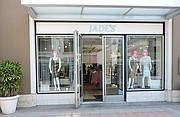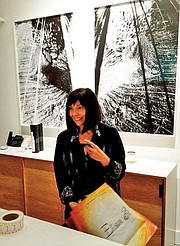Small Apparel Boutiques Stay in the Game With Hands-On Owners
Retail
As of Thursday, March 28, 2019
The secret sauce for store owners to be successful is often very simple—all they have to do is be on-site to give a sense of personality to the outpost and provide personalized service to make clients feel special.
“When the owner is present, it makes a difference for their sales,” said Peter Jacobson, president of Fashion Link, a distributor of European luxury women’s fashion brands, and Creative Concepts, the company’s sales branch, headquartered in Los Angeles’ The New Mart. He has noticed that as businesses expand and store owners aren’t on-site, sales decline.
Paula Rosenblum, managing partner and co-founder of Retail Systems Research in Miami, grew up watching her father manage Sam’s, the family’s apparel store, on New York’s Long Island. “When something new comes in, you can let your customer know, even if it’s just with a postcard or an email.”
Old-fashioned marketing can be everything. “Bigger companies have lost those human touches. This is old fashioned, but I would write handwritten thank-you notes,” said Britt Beemer, president and founder of America’s Research Group in Summerville, S.C., which does surveys of consumers’ shopping habits. “The people who fail are the ones who believe that retail is a transaction, not a relationship between the consumer and a store associate.”
Growing traffic for a small bricks-and-mortar retail operation is a tricky business that requires owners to develop a delicate formula of establishing personalized relationships with customers, knowing trends and employing a dedicated staff.
With the decrease in customer brand loyalty, the retail segment has experienced a shift toward an associate culture in which employee allegiance is not high.
“The retail-store model dictates a transient, relatively low-paid workforce,” Rosenblum observed. “As a small, independent retailer you can’t offer employees a career path, so it’s a bit challenging.”
Years ago, store associates were expected to learn the business under the guidance of their supervisors. This is no longer a reality for most employees in the retail space.
“When I was trained in retail, I had to analyze the return on linear investments, but you don’t have that type of training today,” Jacobson said. “Also, a lot of salespeople will wait for customers to come see them as opposed to reaching out to the customer. The most successful salespeople are the ones who reach out and say, ‘You have to come see this.’”
How is bricks-and-mortar succeeding?
At Jade’s in Pasadena, Calif., Marianne Reyes and Kim Holbrook are passionate about cultivating business at their store in The Paseo Pasadena,the town’s central shopping-and-entertainment center.
In their space, the women sell trend-driven and formal pieces that retail from $50 to $500 in sizes 2 through 20 from brands such as the Connecticut-based Commando, in addition to an in-house line, Ginger Los Angeles, which is designed by Holbrook and made locally in downtown Los Angeles.
“We had to be here. It’s our dream and our pride and joy,” Reyes said as she explained how being the independent-boutique destination in a center dominated by corporate apparel businesses such as J. Jill and Chico’s is beneficial for her business.
“We have to know what our customers want,” she said. “We feel good about it because we have other stores here that we can refer them to if they are looking for something different.”
The 1,900-square-foot retail space, which also includes Holbrook’s design studio in the back, is located in a prime corner location. In addition to the camaraderie the women feel with their corporate neighbors, Reyes and Holbrook are determined to become a destination for goods created by local designers and brands that are made domestically.
“Ladies come in every day and say, ‘You have really cool, different things,’” Holbrook said. “We strive to find local designers if we can, goods that are made in America and have different items that you’re not going to find anywhere else.”
A few blocks away, on East Holly Street in Old Pasadena, Elisa Bruley’s Elisa B. boutique sells high-end labels including Alexander Wang, Phillip Lim, Tibi and the luxury sustainable brand Amur (A Mindful Use of Resources), which retail for $10 to $1,300, with an average cost of $150 to $500. After nearly 26 years in business, Bruley and her staff—comprising three salespeople and three marketing experts—host in-store events to provide an experience for clients.
Bruley recently developed her e-commerce and social-media presence over the last year, which has driven traffic to her store.
“There is no denying the power of our web presence. We want to get the website functioning where we are selling consistently on it; however, because of it, people come into the store constantly,” she said. “We’re trying to get everything to coexist.”
While Bruley wants to increase the online presence of her shop, her focus is on remaining a bricks-and-mortar business, where she spends approximately 50 hours per week outside of her additional duties of paying bills, buying new lines and maintaining inventory. For Bruley, being present in her store not only establishes that invaluable connection with clients, but it also informs her decisions regarding the offerings she will stock in the store.
“Getting to know the habits of the shopper informs your buys so much better,” she explained. “It’s so good to know what your clients respond to. You can’t develop relationships and cultivate loyalty if you don’t have the goods. If you’re on the floor, they’re going to tell you what they’re responding to.”
Echoing this sentiment, Jacobson says that when retail-business proprietors work on-site, they are available for customer feedback regarding all facets, from in-stock inventory offerings to the arrangement of pieces.
“Be open to change. Be responsive to needs,” he said. “Don’t take criticism personally, and merchandise. Today, a lot of the stores are not well merchandised.”



